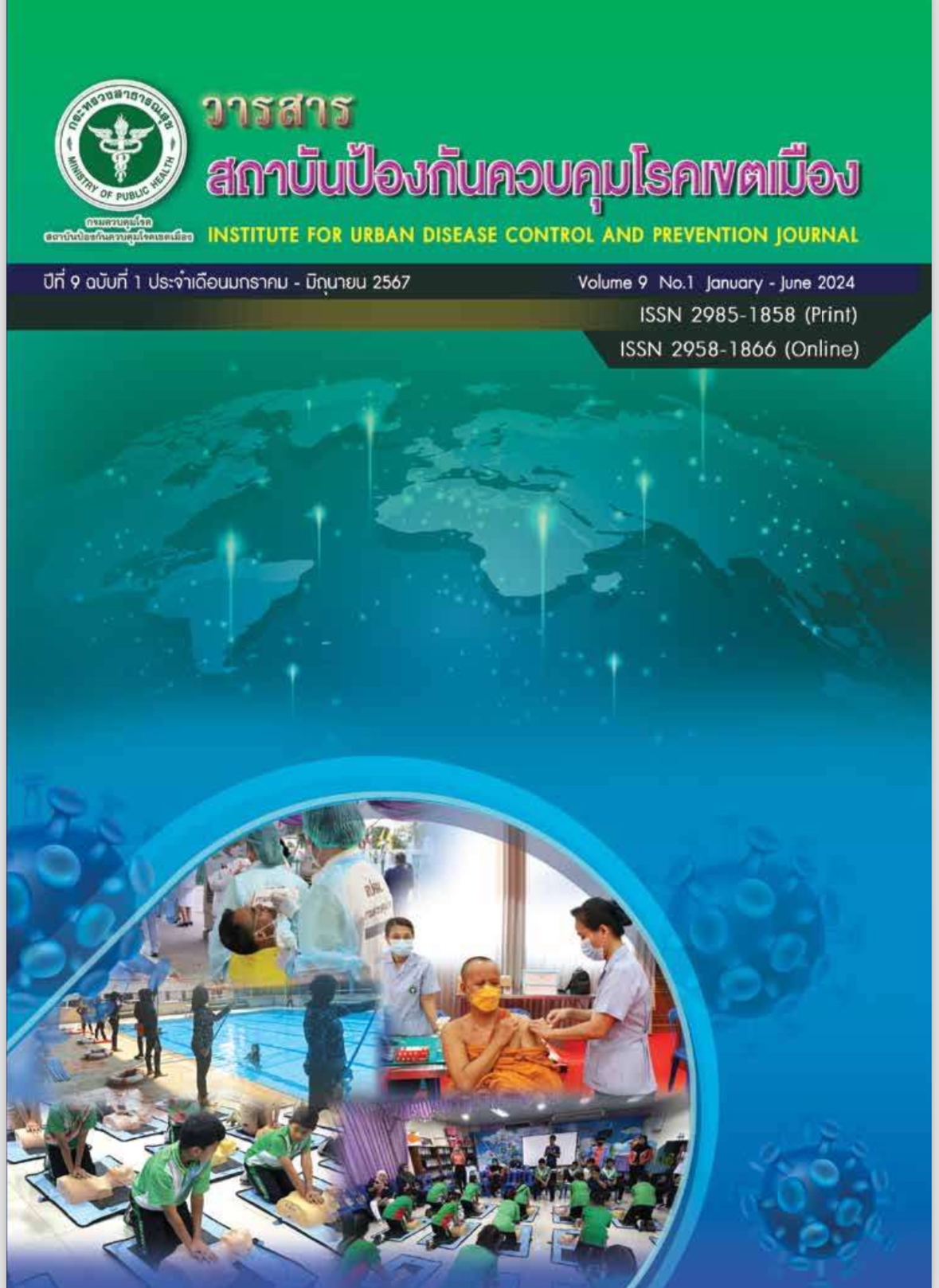รายงานการศึกษาการดำเนินการเฝ้าระวังป้องกันโรคติดต่อระหว่างประเทศ: กรณีศึกษาการเฝ้าระวังป้องกันโรคไข้เหลือง ด่านควบคุมโรคติดต่อระหว่างประเทศ ท่าอากาศยานดอนเมือง ปี พ.ศ.2558-2562
Main Article Content
บทคัดย่อ
การศึกษาเชิงพรรณนาในครั้งนี้ มีวัตถุประสงค์เพื่อศึกษาสถานการณ์การเฝ้าระวังป้องกันโรคติดต่อระหว่างประเทศ กรณีการเฝ้าระวังป้องกันโรคไข้เหลือง โดยการตรวจคัดกรองผู้เดินทางจากพื้นที่เขตติดโรคหรือพื้นที่ที่ได้รับผลกระทบจากโรคไข้เหลืองในช่วงปี พ.ศ. 2558 - 2562 ของด่านควบคุมโรคติดต่อระหว่างประเทศ ท่าอากาศยานดอนเมือง รวบรวมข้อมูลปฐมภูมิและ
ทุติยภูมิจากการคัดกรองผู้เดินทางจากเขตติดโรคไข้เหลือง ผ่านระบบ E-screening และการตอบแบบสำรวจปัญหา อุปสรรคของเจ้าหน้าที่ด่านควบคุมโรคท่าอากาศยานดอนเมือง จำนวน 5 ท่าน
ผลการศึกษาพบว่า ตั้งแต่ ปี พ.ศ 2558-2562 มีจำนวนผู้เดินทางจากพื้นที่เขตติดโรคไข้เหลือง ทั้งหมด 116,086คน เดินทางมามากที่สุด เดือนมกราคม (ร้อยละ 12.14) น้อยที่สุดเดือนกันยายน (ร้อยละ 5) และเพิ่มขึ้นในช่วงสิ้นปี มีจำนวนผู้เดินทางที่มีเอกสารรับรองการฉีดไข้เหลืองครบถ้วน ถูกต้อง จำนวน 96,086 คน (ร้อยละ 82.77) ไม่มีเอกสารรับรองการฉีดไข้เหลืองหรือเอกสารไม่ครบถ้วน ถูกต้อง จำนวน 20,000 คน (ร้อยละ 17.23) ในปี พ.ศ. 2562 สัญชาติที่เดินทางมายังราชอาณาจักรไทยผ่านการคัดกรองที่ด่านควบคุมโรค ท่าอากาศยานดอนเมืองมากที่สุด คือ บราซิล ร้อยละ 48.20 รองลงมาคือ อาร์เจนตินา ร้อยละ 21.87 และน้อยที่สุด คือ เอกวาดอร์ ร้อยละ 1.63 ปัญหา อุปสรรคของเจ้าหน้าที่ที่ปฏิบัติงานการตรวจคัดกรอง คือ 1) ระบบฐานข้อมูลการคัดกรองที่สามารถใช้ประโยชน์ของข้อมูลในการพัฒนาร่วมกันยังขาดประสิทธิภาพ รวมไปถึงยังไม่มีการเชื่อมต่อข้อมูลกับด่านตรวจคนเข้าเมือง 2) คู่มือแนวทาง ขั้นตอนมาตรฐานการตรวจคัดกรอง ผู้เดินทางที่มาจากพื้นที่ที่ได้รับผลกระทบจากโรคไข้เหลือง (SOP) ที่ด่านควบคุมโรคติดต่อระหว่างประเทศ ท่าอากาศยานดอนเมือง ไม่เป็นปัจจุบัน 3) ช่องทางการประสานงานของหน่วยงานที่เกี่ยวข้องในการตรวจคัดกรองและติดตามข้อมูลการเดินทางเพื่อป้องกันโรคติดต่อระหว่างประเทศ ตลอดจนผู้ที่เกี่ยวข้องทุกระดับ มีจำกัด 4) ทรัพยากรบุคคลเพื่อปฏิบัติงานในช่วงที่มีแนวโน้มผู้เดินทางเข้าประเทศจำนวนมากไม่เพียงพอ
จากการศึกษามีข้อเสนอแนะ ดังนี้ คือ 1) ควรมีการพัฒนาประสิทธิภาพระบบการคัดกรองและฐานข้อมูลของผู้เดินทางให้ทันสมัยและบูรณาการฐานข้อมูลหน่วยงานที่เกี่ยวข้อง 2) ควรพัฒนาคู่มือการปฏิบัติงาน (Standard Operating Procedure) ให้เป็นปัจจุบัน 3) เพิ่มช่องทางการประสานงานของหน่วยงานที่เกี่ยวข้องในการตรวจคัดกรองและติดตามข้อมูลการเดินทางเพื่อป้องกันโรคติดต่อระหว่างประเทศ 4) เพิ่มทรัพยากรบุคคลเพื่อปฏิบัติงานในช่วงที่มีแนวโน้มผู้เดินทางเข้าประเทศ
Article Details

อนุญาตภายใต้เงื่อนไข Creative Commons Attribution-NonCommercial-NoDerivatives 4.0 International License.
บทความที่พิมพ์ในวารสารสถาบันป้องกันควบคุมโรคเขตเมือง ถือว่าเป็นผลงานวิชาการ งานวิจัยและวิเคราะห์ ตลอดจนเป็นความเห็นส่วนตัวของผู้เขียนเอง ไม่ใช่ความเห็นของสถาบันป้องกันควบคุมโรคเขตเมือง หรือคณะบรรณาธิการแต่ประการใด ผู้เขียนจำต้องรับผิดชอบต่อบทความของตน
เอกสารอ้างอิง
กองทุนประชากรแห่งสหประชาชาติ (UNFPA). ผลกระทบของการเปลี่ยนแปลงทางประชากรในประเทศไทย. กรุงเทพฯ: กองทุนประชากรแห่งสหประชาชาติ; 2553.
สุชาต อุดมโสภกิจ, จรายพร ศรีศศลักษณ์, อรพรรณ ศรีสุขวัฒนา. ภาพอนาคตระบบสุขภาพ. นนทบุรี:สถาบันวิจัยระบบสาธารณสุข; 2556.
พรหมพร สินพรหม. ภูมิภาคอาเซียน ความเปลี่ยนแปลงด้านสุขภาพ. นนทบุรี: สำนักการสาธารณสุขระหว่างประเทศ สำนักงานปลัดกระทรวงสาธารณสุข; 2558.
กระทรวงสาธารณสุข, กรมควบคุมโรค. กรอบแนวทางการพัฒนาศูนย์ปฏิบัติการภาวะฉุกเฉินและระบบบัญชาการเหตุการณ์ในภาวะฉุกเฉินทางสาธารณสุข กรมควบคุมโรค พ.ศ. 2559-2564. กรุงเทพฯ: ชุมนุมสหกรณ์การเกษตรแห่งประเทศไทยจำกัด; 2558.
กระทรวงสาธารณสุข, กรมควบคุมโรค, สำนักระบาดวิทยา. ที่นี่มีคำตอบ ตอบข้อสงสัยเกี่ยวกับกฎอนามัยระหว่างประเทศ พ.ศ. 2548. กรุงเทพฯ: ชุมนุมสหกรณ์การเกษตรแห่งประเทศไทยจำกัด; 2557.
กระทรวงสาธารณสุข, กรมควบคุมโรค, สำนักสื่อสารความเสี่ยงและพัฒนาพฤติกรรมสุขภาพ. คู่มือโรคติดต่ออันตรายตามพระราชบัญญัติโรคติดต่อ พ.ศ. 2558 สำหรับประชาชน. กรุงเทพฯ: ชุมนุมสหกรณ์การเกษตรแห่งประเทศไทยจำกัด; 2561.
กรมควบคุมโรค. โรคไข้เหลือง. นนทบุรี: กรมควบคุมโรค; 2566.
กระทรวงสาธารณสุข. ประกาศกระทรวงสาธารณสุข เรื่อง ท้องที่หรือเมืองท่านอกราชอาณาจักรที่เป็นเขตติดโรคไข้เหลืองพ.ศ. 2560. ราชกิจจานุเบกษา เล่มที่ 134, ตอนพิเศษ 316 ง (ลงวันที่ 21 ธันวาคม พ.ศ. 2560).
Torresi J, Kollaritsch H. Recommended/Required Travel Vaccines. In: Keystone JS, Kozarsky PE, Connor BA, Nothduft HD, Mendelson M, Leder K, editors. Travel Medicine 4th edition. Amsterdam: Elsevier; 2019. P. 101-24.
Gotuzzo E, Yactayo S, Cordova E. Efficacy and duration of immunity after yellow fever vaccination: systematic review on the need for a booster every 10 years. Am J Trop Med Hyg. 2013;89(3):434-4.
ด่านควบคุมโรคติดต่อระหว่างประเทศ ท่าอากาศยานดอนเมือง. แนวทางการศึกษา ดูงานด่านควบคุมโรคติดต่อระหว่างประเทศ ท่าอากาศยานดอนเมือง. กรุงเทพฯ: ด่านควบคุมโรคติดต่อระหว่างประเทศ ท่าอากาศยานดอนเมือง; 2559.
กรมควบคุมโรค, สำนักโรคติดต่อทั่วไป. แนวทางมาตรฐานการปฏิบัติงาน ด่านควบคุมโรคติดต่อระหว่างประเทศ ท่าอากาศยาน. กรุงเทพฯ: ชุมนุมสหกรณ์การเกษตรแห่งประเทศไทยจำกัด; 2554.
สำนักโรคติดต่อทั่วไป กรมควบคุมโรค กระทรวงสาธารณสุข. คู่มือการประเมินตนเองการพัฒนาสมรรถนะหลักของช่องทางเข้าออกประเทศ ท่าอากาศยาน ท่าเรือ และพรมแดนทางบก. พิมพ์ครั้งที่ 5. กรุงเทพฯ: อักษรกราฟฟิคดีไซน์; 2561.
นรินทร์ทิพย์ ชัยพรมเขียว, ดารารัตน์ ศิริมงคล. รายงานการศึกษาการดำเนินงานเฝ้าระวังป้องกันโรคติดต่อระหว่างประเทศ : กรณีศึกษาการเฝ้าระวังและป้องกันโรคไข้เหลือง ด่านควบคุมโรคติดต่อระหว่างประเทศ ท่าอากาศยานสุวรรณภูมิ ปีงบประมาณ พ.ศ. 2557-2561. สมุทรปราการ: ด่านควบคุมโรคติดต่อระหว่างประเทศ ท่าอากาศยานสุวรรณภูมิ; 2562.


